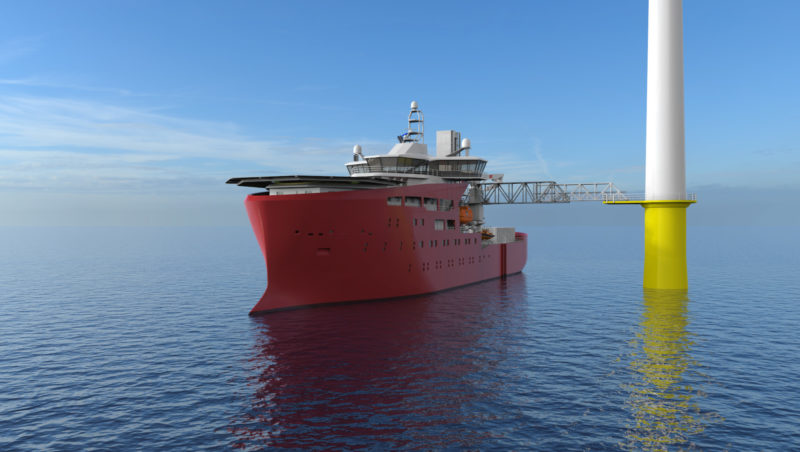With Dominion Energy’s completion of the first two offshore wind turbines on a federal lease, the Virginia-based power company and its partner Ørsted are looking to have the first U.S.-built wind turbine installation vessel – essential to building offshore wind turbine projects – designed and built for a planned 2.6 gigawatt array off Virginia.
“It would be an option for our project, particularly when we get to these larger turbines,” said Mark Mitchell, vice president of generator construction for Dominion, in a June 25 presentation for the online International Partnering Forum hosted by the Business Network for Offshore Wind.
In building the three-phase Virginia project to be complete in 2026, Dominion will be using the next generation of Siemens Gamesa turbines generating up to 14 megawatts and potentially 15 MW each, said G.T. Hollet, Dominion’s director of generation projects.
For its Coastal Virginia Offshore Wind pilot project of two 6 MW turbines, the company used the 459’x140’ installation vessel Vole au Vent – a Luxembourg-flagged vessel, based in Europe like most of the world’s wind turbine installation vessel (WTIV) fleet – to ferry components from Halifax, Nova Scotia, and raise the towers, turbine nacelles and rotor blades.
The price tag for a U.S.-built, Jones Act-compliant WTIV that can carry components direct from U.S. ports to offshore construction site will be steep. “We’ve publicly said that the all-in cost is in the ballpark of $500 million,” said Mitchell.
Meanwhile wind developers and vessel designers are looking beyond the WTIV stage toward service operation vessels (SOVs), workhorses of the industry that in the future U.S. market would be “married to the wind farm contract” and specific projects for their service life, said Michael Braid, a specialist in offshore subsea and renewables with shipping services company Clarksons Platou, based in Houston.
It is “a vessel-intensive industry” with about 400 vessels now worldwide. The U.S. sector will need to follow European design trends, and jump ahead with the advent of much larger, more efficient turbine designs, said Braid: “We’re starting to see a very high-spec evolution.”
Larger, more capable crew transfer vessels (CTVs) are emerging, although for the U.S. East Coast market those high-speed vessels will for some purposes to limited to under 65’ to comply with season speed restrictions to protect migrating whales.
Larger SOVs, with endurance, hotel accommodation for technicians, onboard parts warehousing and other self-sufficiencies are seen as the future for operations and maintenance of offshore wind arrays. In the coming decade, Braid said, he anticipates the new U.S. wind fleet will be heavily weighted with CTVs – “we’re going to need at least 30, maybe 50” – and four to eight newbuild SOVs.
Those SOVs will likely be in the 240’ to 280’ range, said Graham Tyson, a marine specialist with MHI Vestas Offshore Wind’s marine operations and vessel management group. He foresees two-week work periods at sea for SOVs, possibly a month with crew changes.
Designers and operators must carefully consider their future needs and an SOV’s missions over its lifetime to achieve optimal day rates – in a U.S. market where international wind developers are still coming to grips with the reality of higher costs.
“It’s never going to be the same as in Europe, and hopefully developers will price their projects accordingly,” said Tyson.
Vard Marine US began working early with ABS on classifications and approvals for its U.S. market SOV plans, with an agreement announced in December 2019 at the International WorkBoat Show in New Orleans.
One offering sized for the 2020s to 2030s is the 269'x59' Vard 4 04, what the company calls a “design in the volume market for 40 technicians, with focus on efficient logistics and step-less access for all technician operations. It is a flexible platform for transfers via gangway, daughter craft, CTV, helicopter and crane. The operability is class leading because of good motion characteristics and DP capability.”
“This vessel is capability designed and wrapped around the technicians,” with attention to comfort, amenities and workflow,” said Darren Truelock, a Vard vice president based in Houston.
Paul Gallagher, vice president of marine service for Foss Maritime, said SOVs could be priced between $50 million and $100 million, with three years from contract to launch.
Truelock thinks six to eight could be built over five to six years – and as many as 10 to 12 by the mid-2030s. If some of those could be designed and built serially, “we could see the cost go down,” he added.





